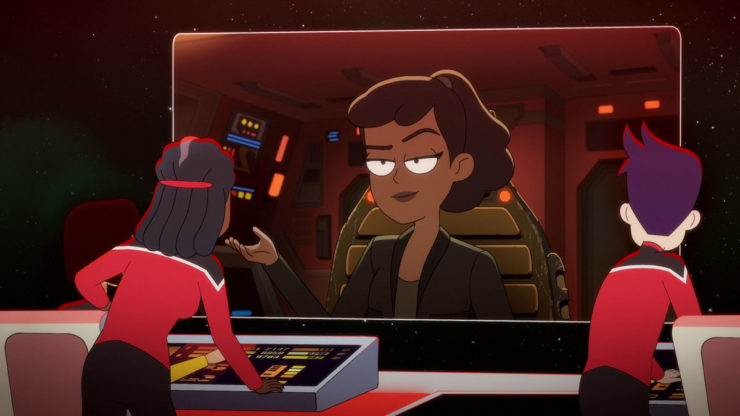One of the great fears of the 1960s was the specter of automation—the notion that people would be replaced by machines that could do a person’s job. Five decades on, some of those fears became realized—but also not realized, as it’s just really meant a shift in where people work. The existence of transponder toll-taking and self-serve checkout kiosks has not resulted in a major societal upheaval.
The original Star Trek did several allegories to this fear, usually in the form of world-running computers and megalomaniacal androids that Kirk had to dismantle (“Return of the Archons,” “The Apple,” “I, Mudd,” etc.), but the most aggressive allegory was the M-5 computer in “The Ultimate Computer.”
And now it’s Lower Decks’ turn.
SPOILERS AHEAD!
The specter of an automated ship isn’t the only callback to Trek tropes in this third-season finale of LD, as we also get that TNG standby of the evil admiral: Admiral Kennelly in “Ensign Ro,” Admiral John Locke Pressman in “The Pegasus,” Admiral Satie in “The Drumhead,” Admiral Dougherty in Insurrection, etc. In this case, it’s one of this year’s recurring characters, the now-we-realize-it’s-ironically-named Admiral Les Buenamigo. Yes, the guy who’s last name means “good friend” turns out to be a bad guy.
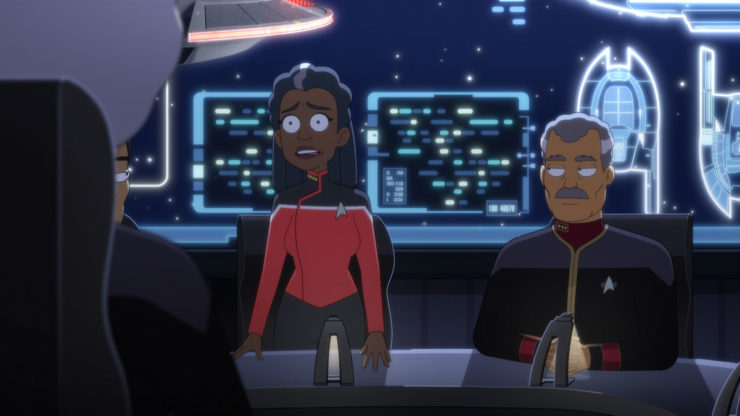
Like the admirals listed above, Buenamigo’s awful behavior comes from a good place: he wants to save lives. The problem, of course, is that he goes about it in a way that endangers lots and lots of lives. In order to bring about the decommissioning of the California class in favor of his Texas-class project, as established last week, he performs a ton of horrible acts, starting with manipulating events so that the Cerritos had to negotiate with the Karemma instead of the Vancouver (“Hear All, Trust Nothing”), hoping that they’d fall on their faces. Given that the Karemma is part of the Dominion, this had the potential to be disastrous for the entire Federation.
After that, he set them up on Brekka (“Trusted Sources”). Turns out he knew about the Breen incursion and kept it from the rest of Starfleet so that the Cerritos would be attacked and the Aledo would save the day. That endangered plenty of lives—starting with all the Brekkians living under Breen rule (at least one of whom was specifically killed because she talked to Ransom). And then he tries to get the Aledo to destroy the Cerritos to cover up his crimes this week.
Oh, yes, and we get some closure on one of the season’s big plotlines: the mysterious command officer who had Rutherford working on a covert program that literally blew up in his face and who ordered Rutherford’s memories erased (“First First Contact,” “Reflections”) was none other than Buenamigo.
Our heroes don’t find this out until after Freeman tries a Hail Mary with the admiralty before they mothball the Cali class: a mission race. Both the Cerritos and the Aledo will perform a series of standard California-class missions, and if the Cerritos finishes first, the class will stay intact.
What causes the Cerritos to lose the race is also what finally uncovers Buenamigo’s mendacity: the Cerritos is setting up an outpost on what everyone thinks is a lifeless planet. But Tendi picks up a reading that might indicate life, and they have to check and make sure it’s not sentient. The entire project grinds to a halt until T’Ana can confirm that it’s not life, just a false positive, as it were.
Here’s the thing: the Aledo didn’t stop. Starfleet protocol is very clear on that subject. It’s when Freeman confronts him about this that the other shoe finally drops. Because up to this point, Buenamigo has been pretty reasonable. He thinks that using automated ships would be far safer, and it’s an argument that one can buy. On the one hand, Starfleet has already been down this road before, as I stated at the top of this review. Part of me was watching this and thinking, “Why would Starfleet even consider this a hundred years after the M-5?”
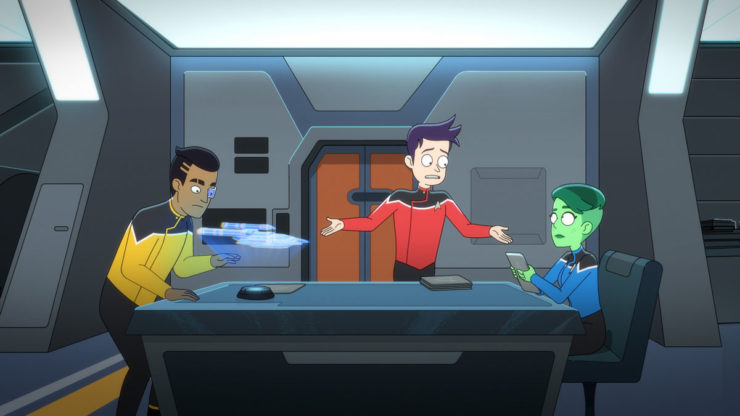
On the other hand, it has been a hundred years, and institutional memory can be a fickle thing. Much more to the point, though, it may be a century after the M-5, but it’s only five years after the Dominion War, and I can see how Starfleet might view an automated ship as a good thing.
And, indeed, one of the flaws in Trek’s world-building over the decades has been its unwillingness to embrace drones and robots and such. Indeed, we never saw anything like that in Trek until Discovery, and we’ve seen precious little of it even there. There are a lot of things in Trek that should be automated.
But, on the third hand (where’s Lieutenant Arex when we need him?), Trek is also about humanity’s future, and how we’re out there to better ourselves. This is the argument Freeman herself makes to the admiralty when they initially agree to decommission the California class, and it’s absolutely the right one to make.
Of course, when it really all goes to hell is when Buenamigo gives the Aledo independent control and orders it to attack the Cerritos. Throughout the episode, Rutherford is looking at the code that runs the Texas class and trying to figure out why it’s so familiar, and then he finally figures it out: it’s the code he created! When he had the accident that resulted in his cybernetic implants (and also when his memory was erased), he was working on an early version of what became the Texas-class ships.
But that’s not the only part that’s familiar: it turns out that the programming has the same flaw that another of Rutherford’s creations had: emotional instability and violent tendencies toward one’s creator. Yes, Rutherford used the same flawed personality coding in both the eventual Texas class and also in Badgey.
Oops.
Aledo turns on its creator, doing considerable damage to the starbase, and killing its “father.” Then it turns on the Cerritos, as well as another ship, the Van Citters, that comes to its rescue.
But the day, in the end, is saved by Mariner, and for once, I’m totally okay with it.
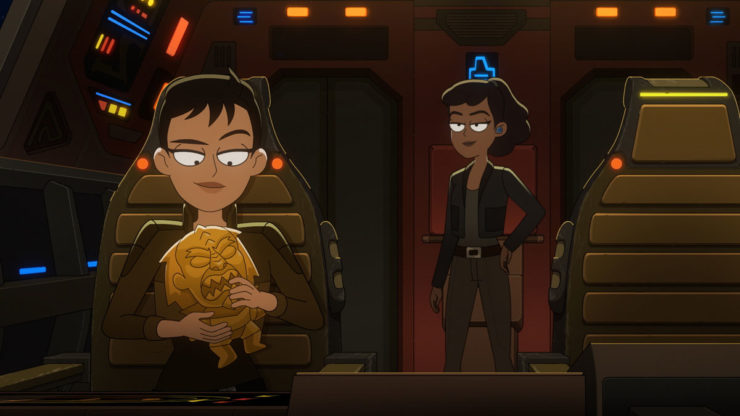
So, Mariner has been bopping around the galaxy playing Indiana Jones to Petra Aberdeen’s Lara Croft (we first see her carrying a gold idol that looks a lot like the one in the opening of Raiders of the Lost Ark while running away from some Ferengi, and I’m really disappointed there wasn’t a giant boulder…), but she soon grows weary of it. Aberdeen has been secretive about who’s funding it, but when Mariner sneakily tries to find out who it is, she’s stunned to learn that it’s Jean-Luc Picard. Aberdeen’s operation is completely above-board, which almost disappoints Mariner, and she soon realizes that she misses Starfleet.
She also sees news reports about the attack on the starbase, and she calls in the cavalry—specifically, all the other California-class ships. In a crowning moment of awesome that one-ups Riker’s arrival with a fleet in the first-season finale of Picard—because, in this case, the ships all being the same class is a plot point instead of a necessary evil due to late production work—the Cali class all gang up on the Aledo and save the day.
The best part is the rapprochement between Freeman and Mariner. Freeman apologizes for doubting Mariner, but Mariner points out that she’s been spending years giving Freeman good reason to doubt her daughter.
And so Mariner’s back. And Tendi is still on the science officer track, and in the end she gets a new study buddy: T’Lyn, last seen in “wej Duj” transferring to Starfleet, and of course she winds up on the Cerritos! I’m very much looking forward to seeing more of her next year, especially having the hyperemotional Tendi paired up with her…
As for Rutherford, on the one hand, his cybernetic implants are a reminder of the horrible things Buenamigo made him do. On the other hand, they have really cool features that he still hasn’t explored all of yet! So he’s keeping them…
Then we have Boimler, who finally gets a bridge buddy! At the top of the episode, Boimler is doing his impersonations of the bridge crew (I especially love his Ransom), but Shaxs walks in when Boimler is impersonating him, and the Bajoran security chief is pissed. Boimler spends the rest of the episode trying to get back in his good graces, but it doesn’t happen until the climactic battle against the Texas-class ships…
Freeman is asking for suggestions. Shaxs suggests ejecting the warp core, like he always does, and nobody pays attention, because they never do. It’s Boimler who interrupts, actually yells at the captain to shut the hell up, and point out that Shaxs’ suggestion is a good one. For his part, Shaxs is over the moon that he finally, after all these years, gets to eject the warp core. It’s a completely ridiculous (in a good way) scene, and it does indeed help save the day, as the warp core takes out the Dallas and the Corpus Christi.
I’m glad they ended this season, not on a cliffhanger, but on an episode that had a nice happy ending for everyone. The California class was redeemed, it was a victory for humanity over automation, and all four of our main characters are in a better place. I’m especially glad they resolved Rutherford’s plotline—and of course he’s sticking with the implants, because he’s a dork.
However, this is the second straight episode (and the third of the last four) of a show called Lower Decks in which the lower-decks characters are really only supporting cast. We saw a lot more of Freeman in these last two episodes than we did our four nominal heroes, and speaking as someone who’s written quite a bit of Trek fiction, it’s a tough needle to thread. The reason why so many Trek stories focus on the captain and the folks in charge is because that’s where the fun stuff is. Yes, there are also stories to be told about the grunts belowdecks, and for the most part LD has been good about telling those stories. But if they also want to do big-ass finales, they wind up giving their main characters short shrift. As it is, they’ve covered it by having Boimler, Tendi, and Rutherford on bridge duty for the important bits, but that’s something else we can’t see too much of, lest we lose the lower-decks feel…
Still, this is a minor complaint about a strong finale.
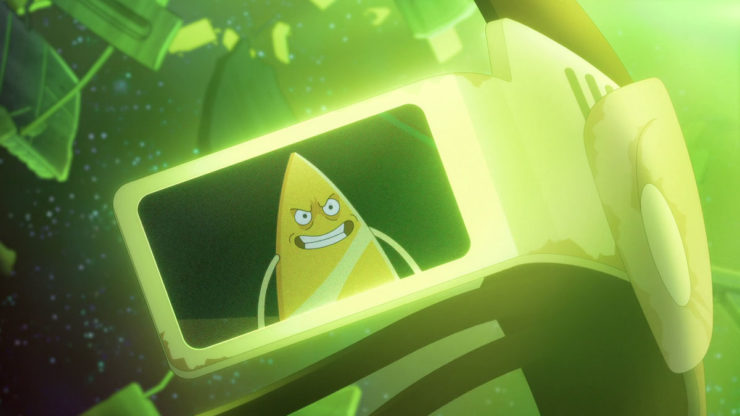
Random thoughts
- Stay through the credits, because there’s a nifty tease for next season there. (See the picture right above this note for a hint…)
- The other Cali-class ships we see include the Oakland (commanded by Captain Ramsey, last seen in “Much Ado About Boimler”), Merced (commanded by Captain Durango, last seen in “Moist Vessel”), Carlsbad (commanded by Captain Maier, last seen in “Mining the Mind’s Mines”), Englewood (commanded by an entirely Bolian crew from the looks of it), Alhambra (commanded by a man who looks a lot like Freeman, with a bridge crew that looks very similar to that of the Cerritos crew, last seen in “Veritas”), San Diego, San Clemente, Sherman Oaks, Burbank, Fresno, Santa Monica, San Jose, Sacramento, Culver City, Anaheim, Riverside, Vallejo, Eureka, Redding, West Covina, Vacaville, Mount Shasta, and one or two more.
- The display for the Texas-class AI is the exact same interface as that of the M-5 in “The Ultimate Computer,” which is a bit on-the-nose, but an effective, if obvious, bit of foreshadowing…
- At one point, Buenamigo lets loose with a mad cackle, and I gotta say that Carlos Alazraqui does a beautiful diabolical laugh. (Alazraqui is also the father of Rylee Alazraqui, who voices Rohk-Tak on Prodigy.)
- Mariner refers to Aberdeen’s patron as Admiral Picard. According to the press notes on Picard season one, 2381 is the year that Picard accepted a promotion and formed the fleet to help the Romulans, and based on the stardates we’ve gotten this season, it’s still 2381 on LD, so that all tracks nicely.
- While we got closure on Rutherford, we’ve still got two plotlines dangling, hopefully to be picked up next year: Boimler’s transporter twin being recruited by Section 31 and AGIMUS and Peanut Hamper forming the beginning of a beautiful friendship.
- The U.S.S. Van Citters is named after John Van Citters, who has been in charge of approvals for CBS Licensing for many years now. JVC, as we all affectionately call him, is the person who approves Trek tie-in fiction, and he’s always been an absolute joy to work with. (Among other things, JVC was the creative force behind your humble reviewer’s 2014 coffee-table book The Klingon Art of War.)
Keith R.A. DeCandido will also cover the first three episodes of season 1.5 of Star Trek: Prodigy here on Tor.com in a few weeks.










